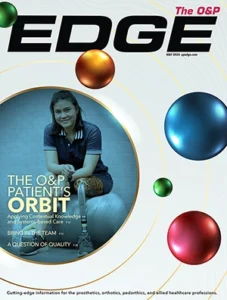Below are the responses and original question about my equino-varus case. Thank you all for your responses.
__________________________________________________
I’ve been asked if I can come up with a solution for a nursing home patient and I thought I would post it here to see what you all thought.
50 yo male, obese (350) diabetic patient who has had previous cva as well as other medical and mental issues. He has been somewhat neglected for several months but is now interested and motivated to begin working on ambulation. His hips and knees are in good shape but his feet have about 30 degree plantar flexion contractures and severe varus contractures as well. He has ulcers on the lateral side of both feet at the 5th met heads.
Therapy is willing to work with him to increase his range of motion but he complains of pain during stretching. I would like to know if there is a way to dynamically stretch him in both planes at the same time with a single orthosis or other possible alternatives.
He is on medicaid and, in Texas, that means no funding if you’re over 21. I could possibly get the facility to pay for orthoses.
Please let me know your thoughts and what you have been successful with in similar cases. I will post replies without names if desired.
________________________________________________________
________________________________________________________
what about serial casting?
that way, you may be able to stretch him out and allow him to ambulate in the meantime. you would need to well pad the ulcerated area, and maybe create an obturator to keep an eye on the wound…
________________________________________________________
I have used a prafo dda from anatomical concepts with varying degrees of success in situations like this.
________________________________________________________
Yours is a very diffucult case for a number of reasons. The solution is a long term use of custom molded contracture reducing orthoses such as can be provided by Ultraflex. The problems is not only funding, but ensuring that the patient and staff knows what will be required to comply with the treatment, mainly that the orthoses must be properly applied and worn for the 10 to 12 hours per day (7 days a week) required to reduce the contractures. The orthoses must be made in such a way as to keep pressure off the ulcers, so that they will continue to heal. I would sugggest that you explain the recommended treatment and all its potential difficulties and pitfalls, and then even if they come up with the funding, insist that the foot ulcers completely heal before you make the orthoses.
_______________________________________________________________
I work very closely with a few Nursing Homes here in Australia and have faced similar problems.
First ascertain the cognitive capacity of your patient: is he likely to continue with this sudden motivation?
If he is diabetic as well as obese, how much physical work will he be able to do before he (or his body) says enough?
Serial orthoses WITH DAILY HANDS ON STRETCHING are about your most realistic option to get the feet to a sensible weight bearing point.
What is the condition of his long weight bearing bones after so much time non-bearing? Daily work to reinstitute the bone integrity will be necessary.
I have not seen such long term contractures reduced completely in thirty years of practice as an OT and a P&O.
Pressure areas almost inevitably resultant from the work and appliances involved are a very real risk.
This is a LONG term case.
Good luck and wise decision making.
______________________________________________________________
I have had the opportunity to work with the type of deformity you have described here.
We have had success building an orthosis that utilizes a multi-positional joint with the patient starting in an extreme plantar-flexed position and using a buildup to create what could be described as a weight bearing “tibial neutral.”
The orthosis is fabricated with an anterior panel that extends to the metatarsals, it is also important that you extend the medial trim-line on the foot section distal enough to control forefoot adduction.
As the patient gains range at the ankle you remove a portion of the buildup Maintaining the same tibial to floor or tibial neutral position.
The buildup is also extended laterally to help control the tendency toward varus.
_______________________________________________________________
I’ve used a combination of an adjustable plantar stop and the center for orthopedic designs adjustable ankle joints for a similar contracture pattern.
_______________________________________________________________
I have used the turnbuckle AFO in cases similar to this with good results, it allows for adjustment in both dorsi and plantar flexion and inversion/eversion, compliance is key and modifications to footplate may be necessary to accommodate ulcers in your case. The one I have used is available from Alimed 1-800-225-2610 /item#60879.
_______________________________________________________________
Look into the Lively orthosis .Most central fab facilities should be able to make it or components can be purchased from Pel supply or Cascade .
_______________________________________________________________
Really stretching will not work, due to compliance and life long need and there is no real orthosis that will work shy of laminated crow boots and the volumne fluctuations will negate any real 3 point control. Has he had tone meds administered _______________________________________________________________
I have used a AFO’s from Ultra Flex for this. The are custom made from cast and work well for equinovarus contractures. They can be used dynamically or static progresively. Reliefs can be built in for the ulcers. The only down side is that they are not cheap.
_______________________________________________________________
Have you tried ultraflex joints? I have used them with great success, but as far as funding, they can be quite pricey. There is another off the shelf orthotic made by Neuroflex that states that they can stretch in multiple planes, I have not used that particular product.
_______________________________________________________________
on my 17 year´s experience working with neurological patients , the best results in cases like that , were far with a procedure called serial casting that I don´t know if you are familiar with , but it´s very commom among phisioterapists.Once we managed to bring a 42 year´s old man( mental
12years) from his 45 degrees of equino varum , to neutral position on four months of working hard.It took time , several diferent casts , but the results were superb.
Another option would be to cast him with the subtalar joint the closest to neutral respecting the plantar flexion and them work with phisioterapy together with a Tamarack joint AFO dinamically stretching him the whole rest of the time he is not being worked by the therapist.It can also have great results.
_________________________________________________________________
Thanks again to all who responded.
Jim Thelen




